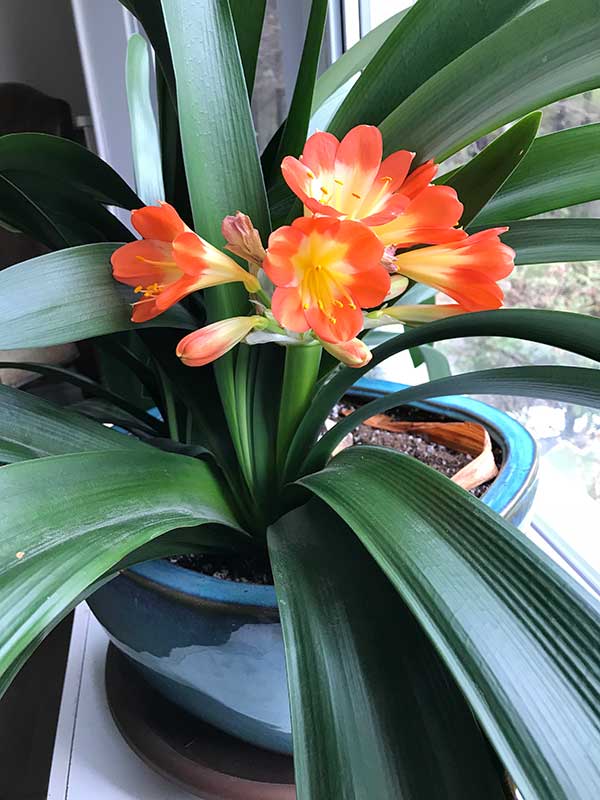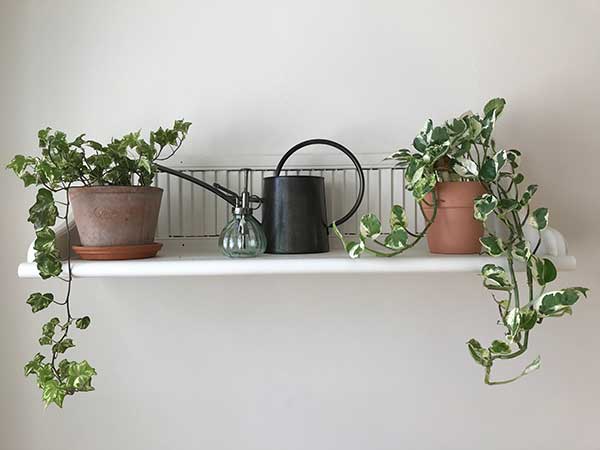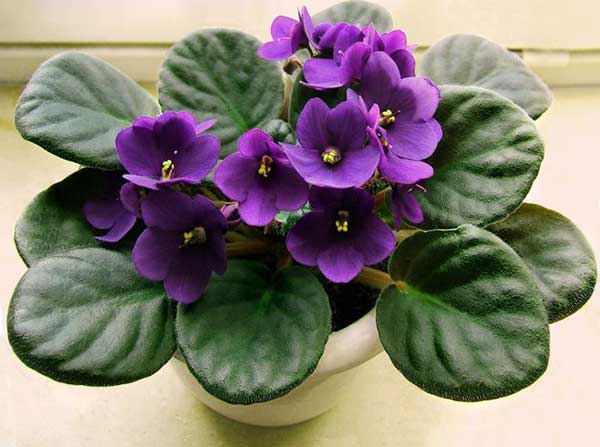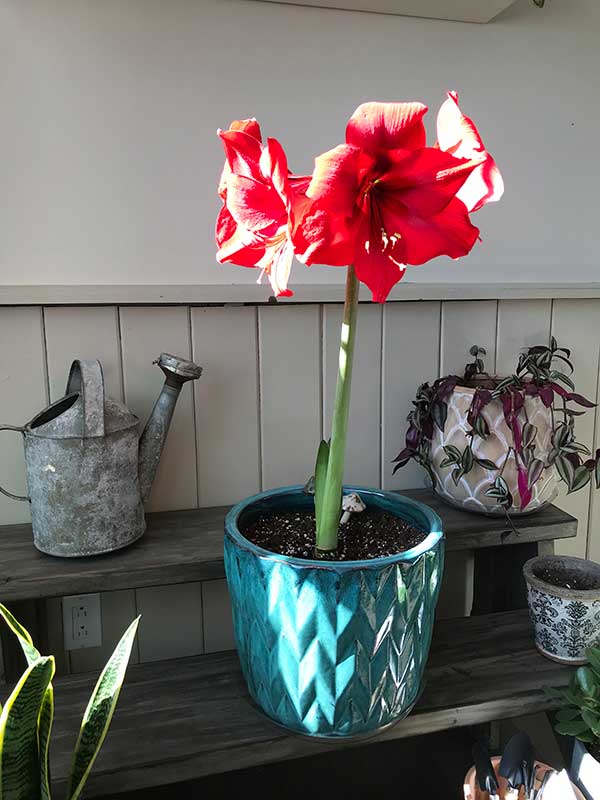Houseplants are an excellent addition to any interior decor. People are spending more time indoors than ever before, so bringing the outdoors in helps us connect with Mother Nature while adding pops of green or other vibrant colors to our spaces. They tide avid gardeners over during the colder months, and many houseplant varieties have been found to purify the air. According to one RHS study, filling your home with them can even improve your skin! Here are just some of the fantastic varieties out there; feel free to list some of your favorites in the comments!
Kaffir Lily (Clivia Miniata)

This no-fuss, nearly indestructible houseplant is a showstopper; so many people have asked about these beauties sitting in my windowsill! Native to South Africa, the Kaffir Lily, or Clivia miniata, is a close relative to the Amaryllis plant. It only blooms twice a year, typically in early spring and again in the fall, but even when it isn’t flowering, the gorgeous, arching, evergreen foliage is enough to keep any plant lover happy. Its trumpet-shaped flowers are worth the wait, opening up in clusters 15-20 strong and in shades of red, orange, salmon, and yellow. Generally inexpensive to buy, Clivia plants last for many years and become more stunning as they age. Its tuberous roots love rich soil, but beyond that, place the plant in a sunny window in a room kept at about 70-75°F. Water it regularly and fertilize the plant during its growth period, from early spring to early fall. Even though the Kaffir lily is super low-maintenance, I have to admit that when its bright orange flowers do bloom, I always think to myself, ‘Dang, my thumb is so green!”
Note: Many gardeners will offer Clivia plants a period of rest from November to January, during which time they are brought into a dark, cold room of about 50°F. I have yet to do this with my plants, and they are still healthy and bloom regularly. Its roots are also poisonous to pets and people, but only if ingested in high amounts.
Ivy (Hedera)

Bare shelves and other furniture pieces are begging to be dressed up, and variegated ivy vines are the perfect solution (unless you have a curious cat!). There are hundreds of different varieties, but some of the more popular include English ivy (Hedera helix), Irish ivy (Hedera hibernica), Japanese ivy (Hedera rhombea), Algerian ivy (Hedera canariensis) Persian ivy (Hedera colchica), Nepal ivy (Hedera nepalensis), and Russian ivy (Hedera pastuchovii). This plant grows long, lush, and quite quickly too. Ivy generally requires a brightly lit room and good drainage. Very wet soil is never a good thing when it comes to this beauty, so allow the earth to dry out before giving it another drink. When the vines begin trailing too long for your taste, prune them back.
Note: While I love the look of English ivy, I keep it well out of reach of my kids and our pets. This plant can be toxic to humans and pets if mistakenly eaten. My ivy plant sits perched up on a high shelf where its vines can spill freely without being a risk to the small critters running around my home.
African Violet (Saintpaulias)

If you’re searching for a low-growing houseplant that looks nice on a desk, windowsill, or countertop, African Violets are always an excellent choice. Pretty clusters of pink, purple, blue, white, or red flowers appear between the fuzzy leaves of this tropical plant, and some blooms even contain two different colors at a time. If treated right, they can flower year-round, but if they don’t, the leaves alone form a beautiful canopy and bring life to any interior decor. African Violets are very temperamental, so to improve the plant’s chances of going into bloom, it’s important to keep them happy. They prefer bright but indirect light for about 14 hours a day in temperatures between 70-80°F (65°F at night). Never saturate the soil; keep it uniformly moist with tepid water, being careful not to splash the leaves. Some gardeners prefer to water this fussy plant from the bottom of the pot. There are also specific African violet fertilizers to help give them the boost they need.
Note: African violets like to be a little bit pot bound but will eventually outgrow their container if their conditions are right. Consider repotting once a year, keeping two-thirds of the original soil and filling the rest with fresh African violet potting mix. This plant is also easy to start from simple leaf cuttings. I’ve bought pretty pots and started new plants as gifts for friends!
Amaryllis (Hippeastrum)

Are you looking for an extremely easy plant to grow with very rewarding blooms? The Amaryllis is a very popular houseplant for those reasons. Native to South America’s tropics, many different varieties are offered with shades of red, white, pink, orange, salmon, and even striped or multicolored flowers. Caring for this plant is a no-brainer. Simply place the Amaryllis bulb in some fertile soil and place the container in a warm location (70°F is ideal) with direct sunlight. Water lightly until the stem begins to appear, then gradually increase the moisture level as the plant grows. The bulb should flower within 7-10 weeks, and when it does, your living space and eyes will be treated to large trumpet-shaped flowers that bloom for a couple of weeks or so.
Note: Once the plant has stopped flowering, cut them off and enjoy the green foliage by continuing to water and fertilize as usual, or you can try to encourage it to flower again by cutting the stem down to the bulb. For periods of continuous color, it’s a good idea to plant multiple bulbs at different times, so there is always something to admire.
Snake Plant (Sansevieria Trifasciata)

No tropical houseplant collection is complete without the snake plant (according to Living Decor, by Maria Colletti)! Super sturdy and un-killable (calling all black thumbs!) the eye is drawn to its tall upward spears that come in different shades of green. There are many different snake plant varieties including Hahnii, a dwarf variety, and Laurentii, which is edged with gold. This houseplant is very tolerant and will do just fine in low-light situations, even if the only source is a light bulb! Watering is fairly occasional, and you must let its soil completely dry before offering it another drink. Because they are technically succulents, feel free to use cactus soil which drains much quicker than other types. Snake plants are lovely additions to smaller areas or a cluster of houseplants because they don’t take up very much room and are still visually very interesting.
Note: The snake plant, also sometimes referred to as Mother-In-Law’s Tongue, was selected as one of the 12 air-improving plants by a NASA study in 1989. It has been found to filter particles in the air and also emits oxygen at night!